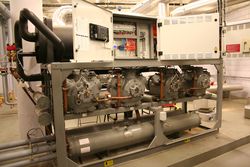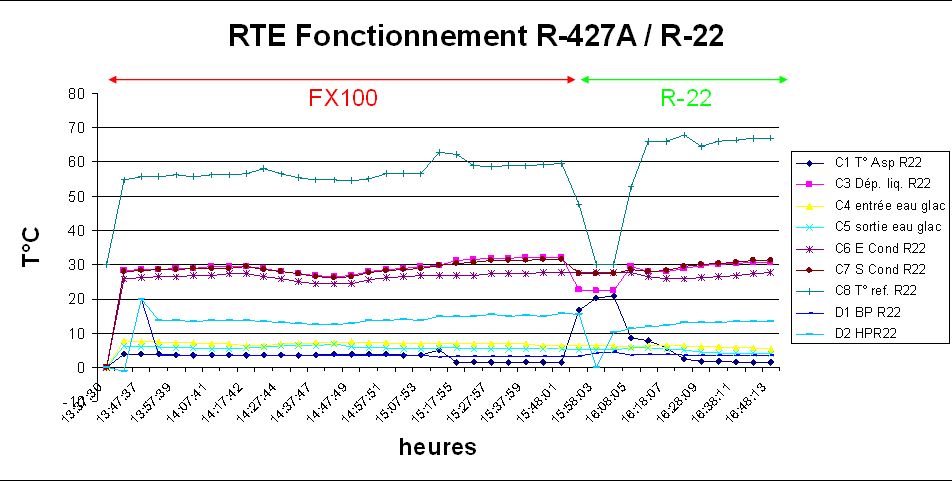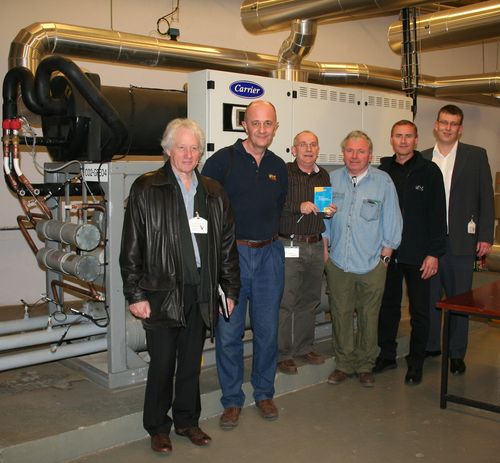To ensure the air conditioning of this system, six R-22 Carrier chilled water units were installed in 1996 and are distributed evenly in two separate equipment rooms. If the unit in one room were to fail, the others immediately pick up the demand, without stopping cooling.
 Since 2007, Jean-Luc Faugeron, technical manager in charge of the site’s operation, aware of upcoming regulatory deadlines on HCFCs, has been bringing an early end to R-22 so as to avoid a repeat of the emergency situation that occurred with the end of R-12 and has given thought to the future of the installations.
Since 2007, Jean-Luc Faugeron, technical manager in charge of the site’s operation, aware of upcoming regulatory deadlines on HCFCs, has been bringing an early end to R-22 so as to avoid a repeat of the emergency situation that occurred with the end of R-12 and has given thought to the future of the installations.
“Faced with the risk of reduced availabilty of regenerated R-22 between 2010 and 2014, and within the scope of our responsible approach towards sustainable development and energy conservation, we needed to look for the best solution to tackle this issue”, explained Jean-Luc Faugeron. What should be done? Replace the chilled water units with new installations, or reconvert them? This was the question.
The new-installation solution was quickly ruled out by RTE due to the high costs it would have involved (demolishing the underground structure, very difficult maintenance to deal with any failure that might occur during the change, etc.). The reconversion solution was then chosen.
R-417A, presented as an effective transition fluid, was tested for three months on one of the units, but it did not meet the volume cooling requirements, proving weaker than R-22. RTE then enlisted Serge François, Director of Technical Applications at Climalife to investigate their problem.
After comparative thermodynamic and energy modelling with off-the-shelf solutions, specifically R-422D, R-407C and R-427A in accordance with RTE’s request, Climalife gave its highest recommendation to R-427A for its lower energy consumption and cooling comparable to the R-22.

The R-407C solution proposed by Carrier was not adopted due to the costs involved in replacing the relief parts, the regulation, and changes to the compressors.
R-422D was tested without changing oil, in accordance with the manufacturer’s recommendations, but the drops in performance were too high, and were accentuated by the excessive oil residue in the multi-tube evaporator. Even with an oil change, the result obtained did not satisfy RTE.
Following the tests conducted on unit #4 with R-427A by Mr. Brunet, the cooling maintenance technician at the site known as Climea, Jean-Luc Faugeron confirmed the choice of this HFC; he also specified that “Climalife’s technical support and guidance was very important; Serge François very quickly understood our problem and was able to help me draft the proposal to convince the board to invest in this solution”.
 At the same time, Mr. Brunet and Jean-Luc Faugeron called upon the company HRS, a specialist in rebuilding cooling compressors, to audit the 4 hermetic compressors found at each of the Carrier units, with a power equal to 410 kW. “During a reconversion with an oil change, it is important to approve the compatibility of the bearings, seals, and oil pumps”, stated Yann Le Guen, the head of HRS. The company then provided and replaced the bearings of these compressors and transmitted the method for replacing them to Climea for action on the 5 other groups to reconvert.
At the same time, Mr. Brunet and Jean-Luc Faugeron called upon the company HRS, a specialist in rebuilding cooling compressors, to audit the 4 hermetic compressors found at each of the Carrier units, with a power equal to 410 kW. “During a reconversion with an oil change, it is important to approve the compatibility of the bearings, seals, and oil pumps”, stated Yann Le Guen, the head of HRS. The company then provided and replaced the bearings of these compressors and transmitted the method for replacing them to Climea for action on the 5 other groups to reconvert.
With the fluid chosen, and the compressor audit complete, all that was left to solve the problem was to regulate the groups.
A market study was produced. Any systems in which all equipment (probes, regulators, etc.) and communications protocols must be of the same brand were ruled out, as they were deemed too restrictive. Carel was selected for its standard products, its open programming, and its competitive price. The possibilities offered by Carel raised a great deal of interest in remote management, which allowed Mr Faugeron to plan new management of these groups via cascading communication.
The Pco-series 3rd-generation logic controller was thereby set up on the first cooling unit by the company SNEF, a Carel-approved partner of CNES. The logic controller integrates a remote touchscreen that reproduces the diagram of the old Carrier regulator used with R-22. “This screen is an asset for a climate technician, who can see everything at a glance during maintenance”, RTE said.
The Carel EVD Driver adjusts the overheating of the R-427A.
In the end, once the reconversion of the six chilled water units is  complete, and the controller is installed on the assembly, bus-mode communication shall be carried out with the cooling towers, which will enable RTE to be self-sufficient and set the climate controls of the computer system on the monitoring screens.
complete, and the controller is installed on the assembly, bus-mode communication shall be carried out with the cooling towers, which will enable RTE to be self-sufficient and set the climate controls of the computer system on the monitoring screens.
Jean-Luc Faugeron is fully satisfied and congratulated all of the stakeholders involved for their guidance and professionalism in leading this project. He further stated that “The choice of cooling fluids must be tailored to each application”.
Auteur : D. Martin

